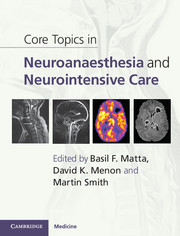Book contents
- Core Topics in Neuroanaesthesia and Neurointensive Care
- Core Topics in Neuroanaesthesia and Neurointensive Care
- Copyright page
- Contents
- Contributors
- Preface
- Acknowledgements
- Section 1 Applied clinical physiology and pharmacology
- Section 2 Monitoring and imaging
- 4 Intracranial pressure
- 5 Bedside measurements of cerebral blood flow
- 6 Cerebral oxygenation
- 7 Brain tissue biochemistry
- 8 Neurophysiology
- 9 Multimodality monitoring
- 10 Imaging
- Section 3 Neuroanaesthesia
- Section 4 Neurointensive care
- Index
- Plates - PDF Only
9 - Multimodality monitoring
from Section 2 - Monitoring and imaging
Published online by Cambridge University Press: 05 December 2011
- Core Topics in Neuroanaesthesia and Neurointensive Care
- Core Topics in Neuroanaesthesia and Neurointensive Care
- Copyright page
- Contents
- Contributors
- Preface
- Acknowledgements
- Section 1 Applied clinical physiology and pharmacology
- Section 2 Monitoring and imaging
- 4 Intracranial pressure
- 5 Bedside measurements of cerebral blood flow
- 6 Cerebral oxygenation
- 7 Brain tissue biochemistry
- 8 Neurophysiology
- 9 Multimodality monitoring
- 10 Imaging
- Section 3 Neuroanaesthesia
- Section 4 Neurointensive care
- Index
- Plates - PDF Only
Summary
Keywords
- Type
- Chapter
- Information
- Core Topics in Neuroanaesthesia and Neurointensive Care , pp. 119 - 127Publisher: Cambridge University PressPrint publication year: 2011



